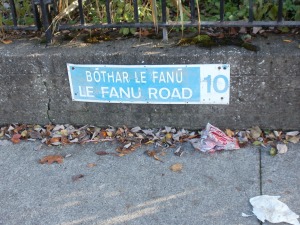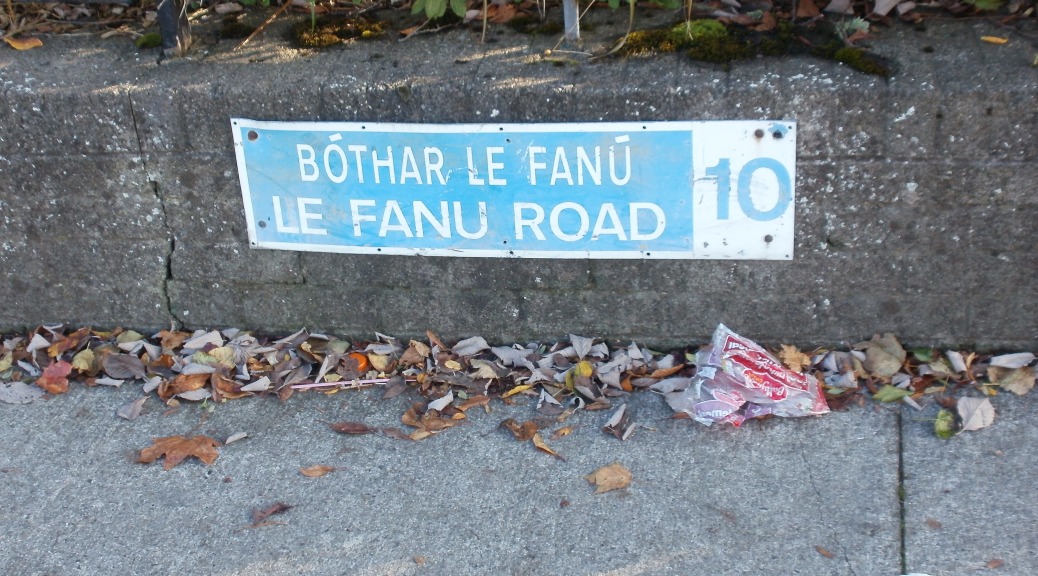In a suburb of West Dublin called Ballyfermot lies the inconspicuous sign pictured below.

The people that live there may not know what the name means or where it leads to but it is the beginning of not only Count Dracula but of the vampire legend itself.
You may wonder why Dublin has such an association with vampires, dear readers, but it becomes clearer when you remember that the festival of Hallowe’en began in pagan Celtic Ireland. Hibernia (or “the land of winter” as the Romans called the Emerald Isle) was awash with superstition and the supernatural. From the Banshee (“bean” is Irish for woman and “shee” is the Anglicized pronunciation of “sídhe” which means fairy or ghost), to the ubiquitous leprechauns (a jovial re-imagining of the malevolent fairies that abducted babies and replaced them with changelings) to Samhain, Lord of the Dead, and the sullen spirit the Púca that walked abroad on Halloween night spitting on fruit to blight it. A writer named Sean Hillen even put forward the theory in 2009 that Stoker got the name of his vampire Dracula from the Celtic phrase ‘droch fhola’ (pronounced ‘druc ulla’) meaning ‘bad blood.’ Once you set the cultural background in place, the concoction of the vampire not only becomes clearer, it becomes almost inevitable.
Irish writer Sheridan Le Fanu (1814 – 1873) wrote one of the first modern vampire stories in his 1871 novella Carmilla. It never stated outright that its vampires were lesbians (the repression of the time saw to that) but the Sapphic overtones were certainly heavily implied and were made explicit in the movie adaptation The Vampire Lovers in 1970.
Le Fanu spent part of his life in nearby Chapelizod, at the bottom of the hill that leads down from the Ballyfermot road named after him (Le Fanu Park also bears his name there). He graduated from Trinity College (I pass Trinity College every day on my way to my social media course in Ballyfermot) and worked as a journalist and wrote an influential vampire story. In doing so, Le Fanu set the template for another Irishman and Dubliner who came after him – Bram Stoker. He too would graduate from Trinity College, work in journalism (as theatre critic for the Dublin Evening Mail newspaper owned by Le Fanu) and write an important vampire tale, Dracula (for most people, THE most important vampire tale of them all). Le Fanu mentored Stoker, he must have been aware of the many similarities between them.
The road to Dracula began early on. Bram Stoker’s mother Charlotte told him hair-raising stories when he was a sickly child of what happened during the great cholera epidemic of 1832 in her native County Sligo. The outbreak began after a suitably spooky, Draculaesque thunderstorm. Stoker’s mother recalled mass graves full of bodies and people being buried alive. The young Stoker was simultaneously terrified and fascinated and the ideas were salted away in his fertile mind for future use.
Those disturbing ideas begat further ones. Stoker’s first real idea for Dracula came to him in a nightmare he had after a late crab supper one evening. He imagined the Brides of Dracula sequence in the novel when a furious Dracula returns to his castle, pushes the female vampires away from Jonathan Harker and says: “This man belongs to me!” (A lot has been made of the homoerotic subtext of that, so again, there is a similarity with Le Fanu and his then-taboo glimpse into what we would probably call LGBT erotica today).
Bram Stoker had the misfortune to die the same week that the Titanic sank in 1912, the 9/11 of its day. His death was buried on the inside pages and he rather faded from the public consciousness until a black-and-white silent German movie by the name of Nosferatu appeared in 1922. It mirrored the story of Stoker’s Dracula closely and his widow sued and won, the judge declaring that all copies of the film Nosferatu be destroyed for infringing copyright. Thankfully, some copies survived and a major part of film history was preserved for future generations to enjoy. It is a truly extraordinary, expressionistic and surrealist tour de force by director F.W. Murnau and his leading man Max Shreck. Today’s movies still reference it all the time and, for many, it remains the definitive Dracula adaptation.
I am also a Dubliner about to publish my take on vampires, The Vorbing. I will reveal, for the first time, the logo I designed for it myself earlier today (let me know what you think in the comments section, I also have a new Twitter page here; https://twitter.com/TheVorbing).

I knew Le Fanu Road was somewhere in Ballyfermot. I had no idea it was about a minute from where I was studying and for there to be such an immediate connection geographically and literally with what I am about to publish. Indeed, I started writing about Chapelizod for some reason months before I had ever heard about the current course I am doing. Strange, as I have never been to the place before now (Le Fanu’s birthday is even one day before mine, Stoker was one inch shorter than me, our surnames begin with St and both our ideas for our vampire novels came to us in nightmares. Okay, I’ll stop there). It was as if something was calling me there. Yes, the Brides of Dracula were whispering seductively in my ear. Oh, to taste that forbidden fruit. Ah, but that way, dear friends, lies the road to hell and don’t we all enjoy visiting there now and then?
© 2014, Stewart Stafford. All rights reserved.
If you’re a generous person who believes this writer should be paid for his hard work, you may donate here.
To read more of this author’s work, check out his short story Nightfall and novel The Vorbing.

Oh, hello fellow vampire lover! I just found your link in one of the FB groups and now I am so glad I read your blog post. Will check out your novel, since the Celtic origins are very close to my heart (and soul) 🙂
LikeLiked by 1 person
I’m so glad you liked my blog post and I hope you enjoy my book as much. It took me 19 years to get it out there and it was a real labour of love.
LikeLiked by 1 person
I will be sure to leave a review when I have read it 🙂
LikeLiked by 1 person
Great! Thank you so much
LikeLike
Reblogged this on Arthurian Romances and commented:
A great article about Dracula and Dublin, Ireland by my brilliant cousin, Stewart Stafford! Enjoy!
LikeLiked by 1 person
Thanks cuz! xoxo
LikeLiked by 1 person
Loved it! Can’t wait for the book! XOXOX
LikeLiked by 1 person